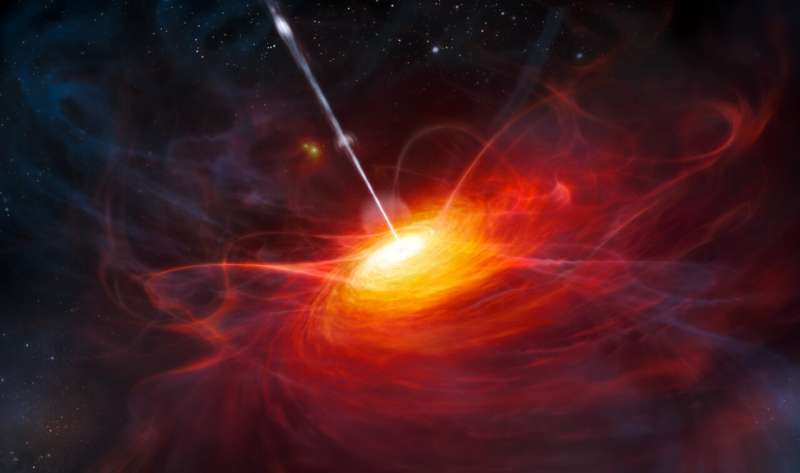January 13, 2021 report
Study investigates emission from a distant red quasar

Using the Atacama Large Millimeter/submillimeter Array (ALMA) in Chile, an international team of astronomers has performed observations of HSC J120505.09−000027.9—the most distant red quasar so far detected and found that it showcases an extended emission of ionized carbon. The finding is reported in a paper published January 4 on arXiv.org.
Quasars, or quasi-stellar objects (QSOs), are extremely luminous active galactic nuclei (AGN) containing supermassive central black holes with accretion disks. Their redshifts are measured from the strong spectral lines that dominate their visible and ultraviolet spectra. Some QSOs are dust-reddened, hence dubbed red quasars. These objects have a non-negligible amount of dust extinction, but are not completely obscured.
Astronomers are especially interested in studying high-redshift quasars (at redshift higher than 5.0) as they are the most luminous and most distant compact objects in the observable universe. Spectra of such QSOs can be used to estimate the mass of supermassive black holes that constrain the evolution and formation models of quasars. Therefore, high-redshift quasars could serve as a powerful tool to probe the early universe.
At a redshift of 6.72 and with dust reddening at a level of, HSC J120505.09−000027.9 (J1205−0000 for short) is the most distant red quasar known to date and the only high-redshift red quasar so far identified. Previous observations have found that the quasar showcases prominent broad absorption lines (BALs) as well, indicating the existence of nuclear fast outflows.
In order to get more insights into these nuclear outflows from J1205−0000 and to better understand the emission from this source in general, a group of astronomers led by Takuma Izumi of the National Astronomical Observatory of Japan has performed [C II] 158 µm line and far-infrared (FIR) continuum emission observations toward this quasar using ALMA.
"We observed the redshifted [C II] line and FIR continuum emission of J1205−0000 in Band 6 on February 26, 2020, with 41 antennas. Our observations were conducted in a single pointing with a 24′′ diameter field of view," the researchers wrote in the paper.
The study found that the C II emission is spatially more extended (on scales of over 16,300 light years) than the FIR continuum emission. The CII line luminosity is at a level of 1.9 billion solar luminosities, while the FIR continuum emission appears to be brighter—with a luminosity of around 2.7 trillion solar luminosities.
The obtained luminosity values allowed the team to calculate the upper limit for the star formation rate (SFR) of J1205−0000's host galaxy. They found that the SFR should not exceed 575 solar masses per year.
The origin of the detected spatially extended C II emission is still uncertain. According to the authors of the paper, possible explanations include companion/merging galaxies and cold outflows. They added that both scenarios well fit into the merger-induced galaxy evolution scenario.
"If the extended structure is due to (multiple) companion/merging galaxies, this indicates that this red quasar indeed emerges with a merger event. [...] If the extended structure is due to cold outflows, we can argue that this red quasar is in a key transition phase from a dusty starburst by blowing its surrounding medium," the astronomers concluded.
More information: Subaru High-z Exploration of Low-Luminosity Quasars (SHELLQs) XII. Extended [C II] Structure (Merger or Outflow) in a z = 6.72 Red Quasar, arXiv:2101.01199 [astro-ph.GA] arxiv.org/abs/2101.01199
© 2021 Science X Network





















